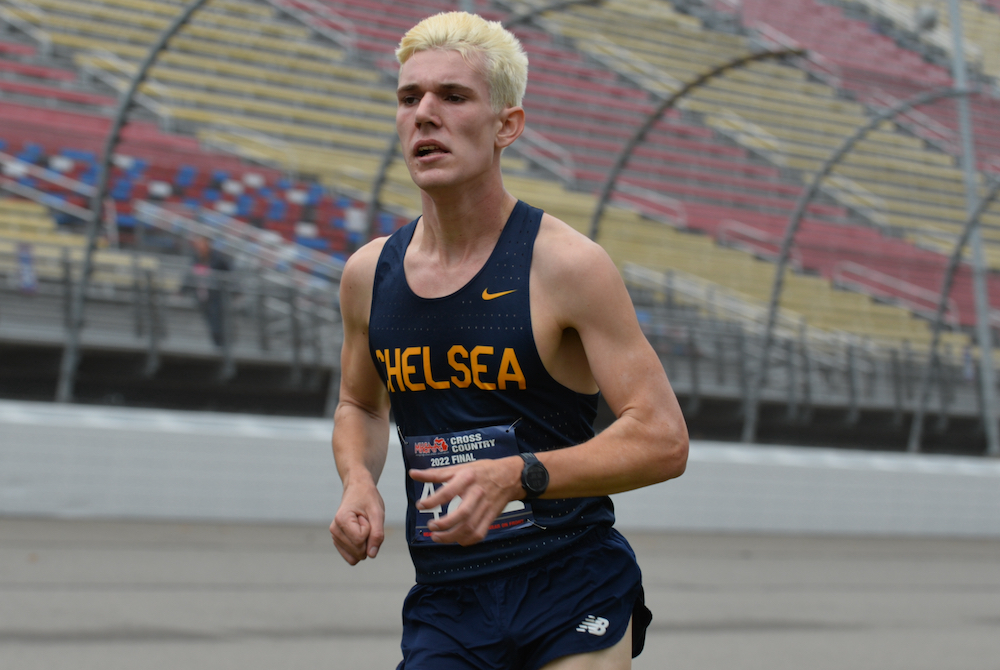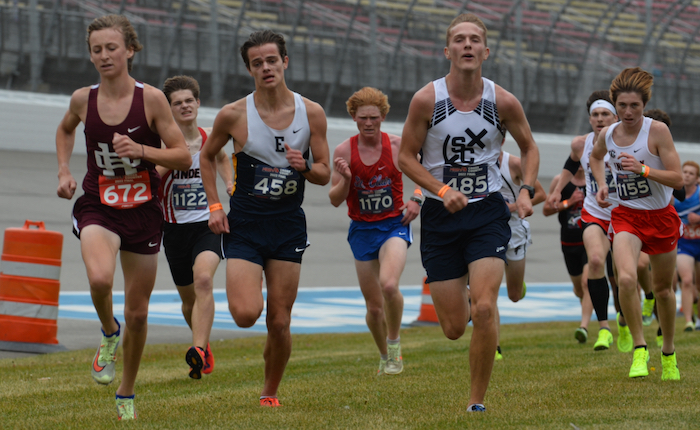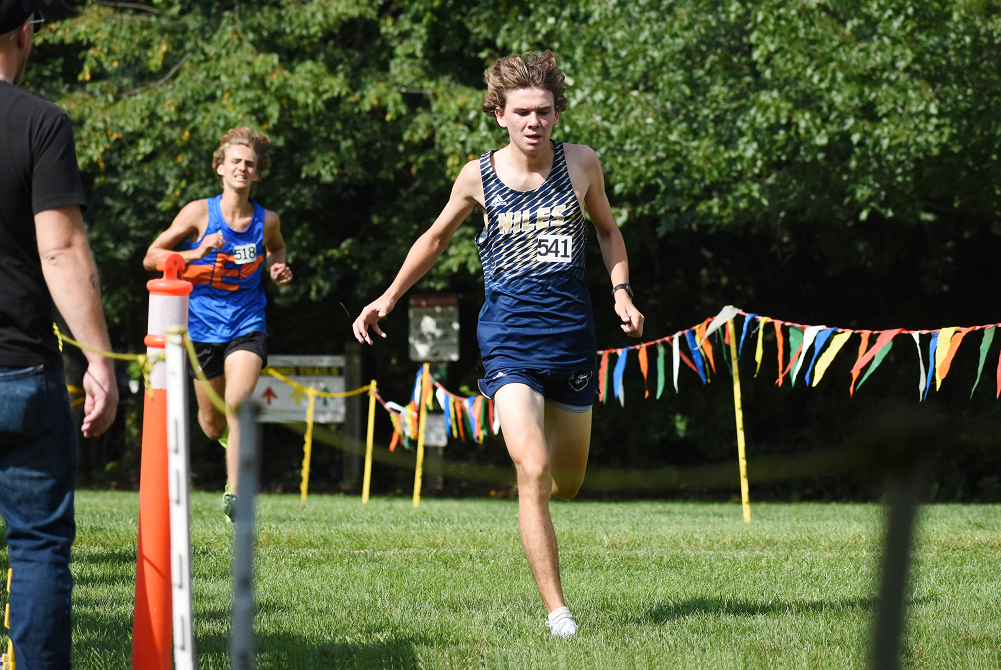
East Grand Rapids, Chelsea's Alford Take Next Steps as 1st-Time Finals Winners
November 5, 2022
BROOKLYN – The seeds that bore fruit Saturday for Chelsea junior Connell Alford were planted five years ago.
After making his first trip to watch the MHSAA Lower Peninsula Cross Country Finals at Michigan International Speedway as a sixth grader, Alford began setting lofty goals for himself.
“In 2017, Chelsea won the team title,” Alford said. “That was my first state meet. Then I saw one of our runners get fifth. I thought, ‘You know what, I want to be a state champion one day.’ Since then, it’s always been a goal.”
Alford isn’t the only runner to dream of becoming a state champion, but he was able to make that dream a reality.
He dominated the field in the Lower Peninsula Division 2 meet, posting a time of 15:12.61 to outpace runner-up Carter McCalister of Monroe Jefferson by 24.93 seconds.
Running solo up front meant having to bear the full brunt of a strong wind. But Alford didn’t want to leave anything to chance after getting outkicked for fourth place last year by Dearborn Divine Child’s Michael Hegarty. Hegarty was fourth this year.
 “I feel like there’s always a wind like that in the last 100 meters, like last year when I got fourth and got outkicked,” Alford said. “My game plan this year was don’t be in the final straight with anyone so I can’t be outkicked.”
“I feel like there’s always a wind like that in the last 100 meters, like last year when I got fourth and got outkicked,” Alford said. “My game plan this year was don’t be in the final straight with anyone so I can’t be outkicked.”
Alford was the prohibitive favorite in Division 2 all season after winning eight of nine meets on his way to MIS and breaking 15 minutes twice. He didn’t see it that way.
“I still can’t totally believe it happened,” he said. “I knew with my performances there would be a shot, but after Regionals it was all open. It could have been anyone. We had super-fast Regionals. I knew there were crazy-fast people in the Regionals. It was still up for grabs in my mind.”
For the second-straight year, a runner from the Southeastern Conference White won the Division 2 title. Alford was preceded atop the podium by Pinckney’s Caleb Jarema, who now runs for the University of Michigan.
“I think last year I had Caleb Jarema in almost every race I ran,” Alford said. “That really helped. I learned stuff he did. I knew I could go off of what he did. He was such a strong runner. I used him as a model of, ‘Hey, I’m going to train so I can do that, too.’”
The SEC White flexed its collective muscles again in Division 2, with three of the top four teams hailing from that six-school division.
East Grand Rapids won the meet with 132 points, but the next three teams were from the SEC White. Chelsea was only five points out of first, Pinckney was 11 back and Adrian was 32 back.
While Chelsea, Pinckney and Adrian had runners in the top 10, East Grand Rapids won with the strength of its pack.
The Pioneers didn’t have a finisher until junior Ryan Brinker crossed in 28th place in 16:19.01, but he soon had company. Junior Alex Thole was 33rd (16:28.79), senior Elijah Robinson was 36th (16:30.52), freshman Jonah Workman was 45th (16:38.09) and junior Davis Christy was 46th (16:40.83).
The team title was the first in boys cross country for the Pioneers.
PHOTOS (Top) Chelsea’s Connell Alford travels the final paces of his LPD2 championship run Saturday. (Middle) East Grand Rapids’ Davis Christy (458) is among leaders of a pack heading toward the finish. (Click for more from Dave McCauley/RunMichigan.com.)

Speedy & Skilled, Krueger Again Boosting Niles' Cross Country, Tennis Teams
By
Scott Hassinger
Special for MHSAA.com
October 3, 2023
NILES – On any autumn weekday afternoon, Aiden Krueger can be found using his legs to carry him across the campus of Niles High School.
 After cross country practice, the Vikings' senior literally runs over to the tennis courts to work out with the boys tennis team.
After cross country practice, the Vikings' senior literally runs over to the tennis courts to work out with the boys tennis team.
The fall dual-sport athlete has managed to make a significant impact on both programs during his career at Niles.
In cross country, Krueger is a two-time Lower Peninsula Division 2 Finals qualifier and recently broke a long-standing school record in the 5,000-meter (3.1 mile) race.
In Saturday's Berrien County Meet held at Lake Township Park in Bridgman, Krueger's first-place time of 15:55.5 broke Jeff Ort's 33-year record of 16:05 set in 1992.
Breaking the school record was one of two main goals that Krueger, the Vikings' No. 1 runner, and his head coach Tony Todd and assistant coach Jason Todd set prior to the start of the 2023 season.
"It felt great to take down a school record that's been there for so long. On the day of the Berrien County Meet, my coaches and I talked about how I felt that day. They could tell I was feeling really good, so we went for it," Krueger said. "I felt great the entire race, and my body responded very well. My coaches were at the one and two-mile mark to let me know where I was at. I was able to squeeze out a record time, and the feeling of being able to share that moment with my family, coaches and teammates was unmatched. It's a day that I'll cherish for a very long time."
While Krueger always has shown a natural ability for running, he soon realized he needed to increase his offseason training in order to reach his career goals.
"Aiden is naturally gifted. He broke the eighth-grade two-mile record in cross country, so we knew he was going to be a special runner. What we didn't know at that time was how strong of a runner he was in terms of his mental preparedness. He was a quick study coming into the program as a freshman, but natural ability will only take you so far. There is a lot more that goes into becoming an elite distance runner," Tony Todd said.
Despite running very little over the summer prior to the start of his freshman season, Krueger still managed to post some respectable times in the 17:20s, but he narrowly missed qualifying for the Finals.
Following a couple of years of running track & field for Niles, and with running higher mileage the last three summers, Krueger feels he has prepared himself well enough to attain his ultimate goal of earning all-state (Top 30) at this year's Finals on Saturday, Nov. 4, at Michigan International Speedway.
"Aiden isn't afraid of hard work. He ran 55 miles per week this summer, and up to this point we haven't backed him off from that number very much," said Niles' head coach. "We've been concentrating on consistency, and once the state meet is about a month away we'll start him on more speedwork."
Krueger, a three-time all-Wolverine Conference and all-Regional runner as well, has the opportunity to graduate as one of Niles' most decorated athletes ever with 14 varsity letters.
Well-respected by his teammates, Krueger was selected as one of the Vikings' team captains this fall.
"Aiden is a very positive person and is always encouraging his teammates," said Niles' head coach.
Entering Tuesday's Wolverine Conference tri-meet in Sturgis with the host Trojans and Otsego, Krueger hadn't lost a league race yet and finished first individually in five of Niles' first eight meets. He ran 16:40 or better in five of those meets as well.
As the season progresses and Krueger prepares for this weekend's prestigious Portage Invitational, he knows what he has to do to reach those goals.
"Right now it's real important for me to get out fast and get into a good position so I can figure out when exactly I need to sit back and when I need to move up," Krueger said.
"As we reach the bigger meets like conference and Regionals, there are a lot of good runners. My coaches help me familiarize myself with who is at those races and who I need to go out and run with. I thank God who gave me the ability to run, along with the support of my coaches and family."
Krueger plans to end his competitive running career once he has finished high school. His parents, Robert and Korrie Krueger, own Milano's Pizza in Niles, and his future plans are to help out with the family business or attend trade school.
Krueger didn't play tennis as a freshman, but made an immediate impact as a doubles player the last two years on the varsity. Since cross country is Krueger's priority sport, Niles head boys tennis coach Jill Weber felt it would be more beneficial for the team if he played singles this fall.
 "Aiden was real receptive to the change. As coaches, we just thought it would be easier to replace him in singles rather than have a doubles partner be forced to play with someone they weren't familiar with," said Weber, who has coached the Niles boys team the last 18 seasons and the girls squad for 20 years.
"Aiden was real receptive to the change. As coaches, we just thought it would be easier to replace him in singles rather than have a doubles partner be forced to play with someone they weren't familiar with," said Weber, who has coached the Niles boys team the last 18 seasons and the girls squad for 20 years.
Krueger was sporting a record of 13-2 and was undefeated in the Wolverine at No. 2 singles at the end of last week. His only losses came in nonleague matches to Coldwater and Kalamazoo Christian.
"Aiden has an extraordinary work ethic. He works really hard, but at the same time he enjoys it and has fun. He usually only needs two or three games to figure out what he needs to do to win a match," Weber said. "I have so much confidence in him to get the job done."
Weber is amazed at how Krueger juggles his time off the court with school and cross country.
She used Saturday, Sept. 9, as an example of his commitment to both sports.
Krueger started that day competing with the cross country team at the Kalamazoo Loy-Norrix Mini-Meet, a race he won in a then personal-best time of 16:31.4. He then jumped in the car with his parents, who drove him to Mattawan where the Vikings' tennis team was competing in a tournament.
"Mattawan was gracious enough to put Aiden on one of the later courts so he could play all three of his matches once he was finished with his cross country meet," Weber explained.
Krueger won all three of his tennis matches.
"That was a pretty exciting day for Aiden. He just takes it all in stride and isn't a showboat on the court. When he's on the court he has a way of making friends with his opponents and makes good calls and shows good sportsmanship. A lot of people have nothing but good things to say about him," Weber said.
"As far as his ability on the court, Aiden is a very tricky player to figure out and has a lot of weapons. He has a good dropshot, can lob the ball, hit an angle shot or hit an approach shot and draw you out of position."
Krueger is well-respected by his tennis teammates as well.
"Everyone loves Aiden. He likes to joke around, but he truly enjoys every one of his teammates and respects them all equally. He's a good student and had the team over to his house for a team dinner recently," Weber said.
Knowing how important Krueger's senior season of running was to him, Weber spoke with Tony Todd before the year began about his role with the tennis and cross country teams.
"I understood how important running is to Aiden this year. The last thing I want to do is stress a kid out. He's done a nice job for us in tennis, but we're not expecting a great deal out of him. I want him to be able to concentrate on his cross country goals," Weber said.
Krueger's older brother Andrew Krueger played tennis for Niles a few years ago, and that sparked Aiden's interest in the game.
"I participated in some summer tennis camps back when I was in seventh grade. I liked my experience playing doubles the last couple years, but singles is a challenge because you have only yourself to rely on and the court is smaller," Krueger said.
Krueger describes himself as confident on the court, and he considers himself more of baseline player.
"I'm really comfortable on the baseline, and my tennis goals are to just try and finish the year with the best record I can in the conference and help my team do as well as we possibly can," Krueger said.
 Scott Hassinger is a contributing sportswriter for Leader Publications and previously served as the sports editor for the Three Rivers Commercial-News from 1994-2022. He can be reached at [email protected] with story ideas for Berrien, Cass, St. Joseph and Branch counties.
Scott Hassinger is a contributing sportswriter for Leader Publications and previously served as the sports editor for the Three Rivers Commercial-News from 1994-2022. He can be reached at [email protected] with story ideas for Berrien, Cass, St. Joseph and Branch counties.
PHOTOS (Top) Niles’ Aiden Krueger crosses the finish line after winning his race during a home meet this season against Edwardsburg. (Middle) Krueger follows through on a forehand shot during a Wolverine Conference match earlier this season. (Top photo by Scott Novak/Leader Publications. Middle photo by Kelly Sweeney/Leader Publications.)

